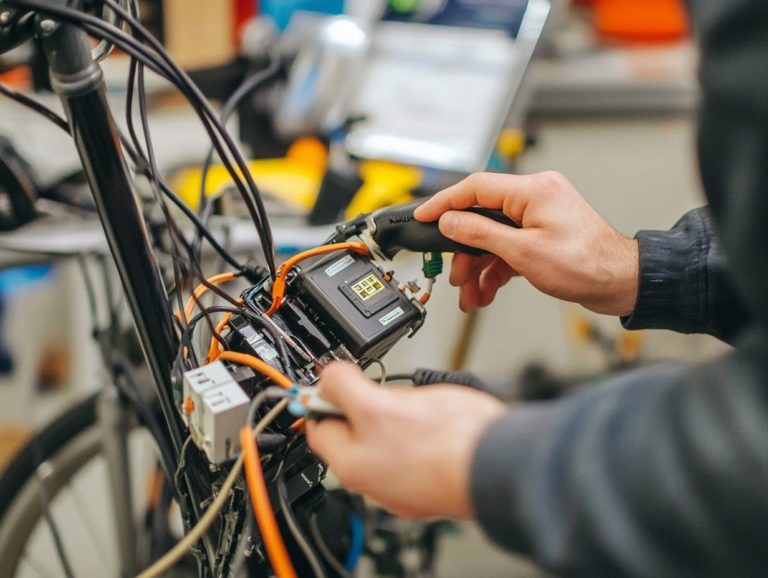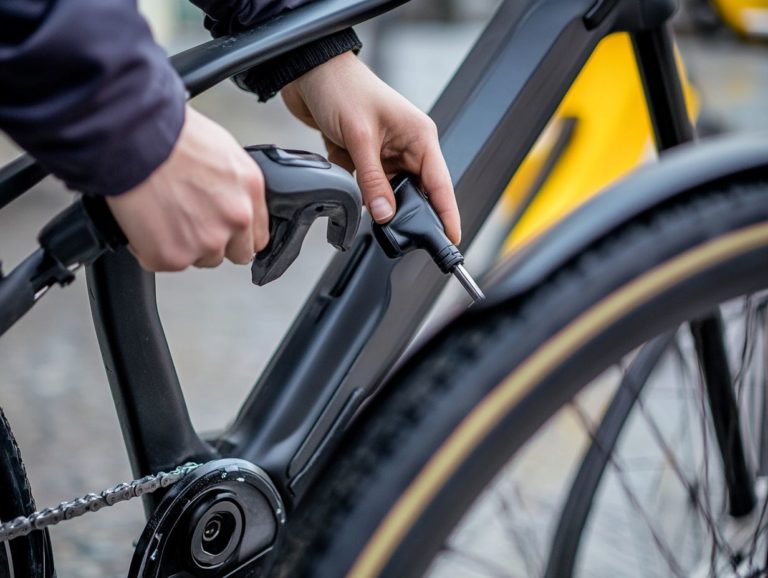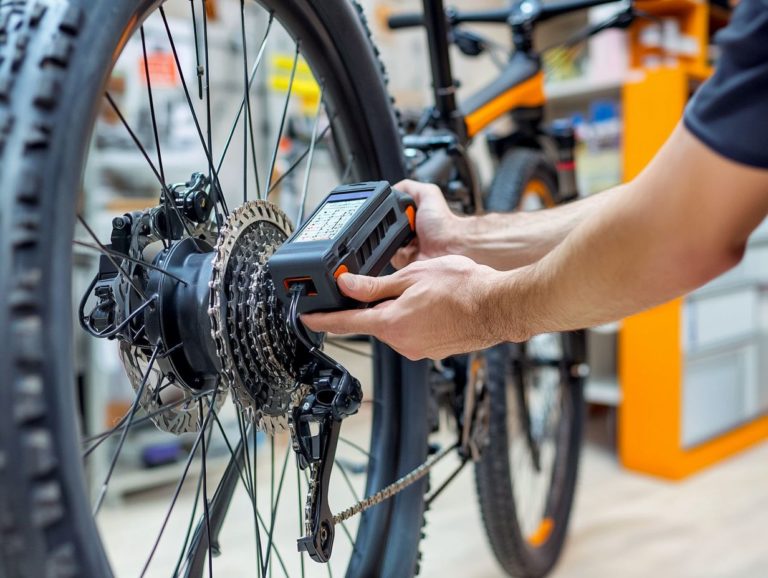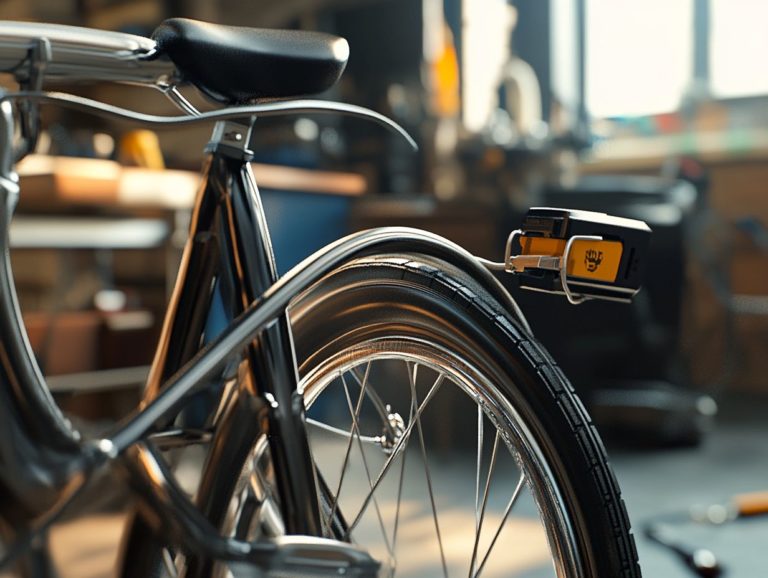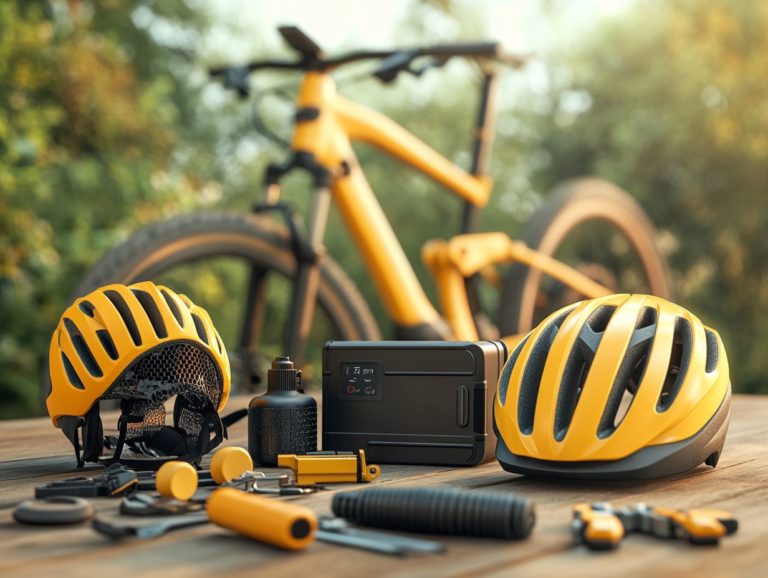Understanding the Anatomy of Your Electric Bicycle
E-bikes are changing the way we commute and have fun. They make cycling thrilling!
By merging the ease of traditional cycling with electric support, these bikes offer a versatile option for riders of all skill levels. They enhance your cycling experience and make it more enjoyable.
Get ready to discover everything you need to know about electric bicycles! This guide will clarify what defines an electric bicycle, explore the various types available, and outline their essential components.
You will also find insights on how to select the perfect e-bike tailored to your needs. Plus, vital maintenance tips will keep your ride in top shape, safety practices to follow while riding, and solutions to common issues that may arise, like ensuring your brake system is functioning properly.
Whether you’re a seasoned cyclist or just stepping into the world of e-bikes, this guide equips you to confidently navigate your journey across diverse terrains and adventures, including how to upgrade parts on your electric bicycle.
Contents
- Key Takeaways:
- The Basics of Electric Bicycles
- The Anatomy of an Electric Bicycle
- Choosing the Right Electric Bicycle for You
- Electric Bicycle Guide
- Factors to Consider
- Maintenance and Care for Your Electric Bicycle
- Safety Tips for Riding an Electric Bicycle
- Common Issues and How to Fix Them
- Frequently Asked Questions
- What components make up an electric bicycle?
- How does the battery work in an electric bicycle?
- What is the difference between a hub motor and a mid-drive motor?
- What role does the display console play in an electric bicycle?
- How does regenerative braking work in an electric bicycle?
- What should I do if I need to replace a component on my electric bicycle?
Key Takeaways:
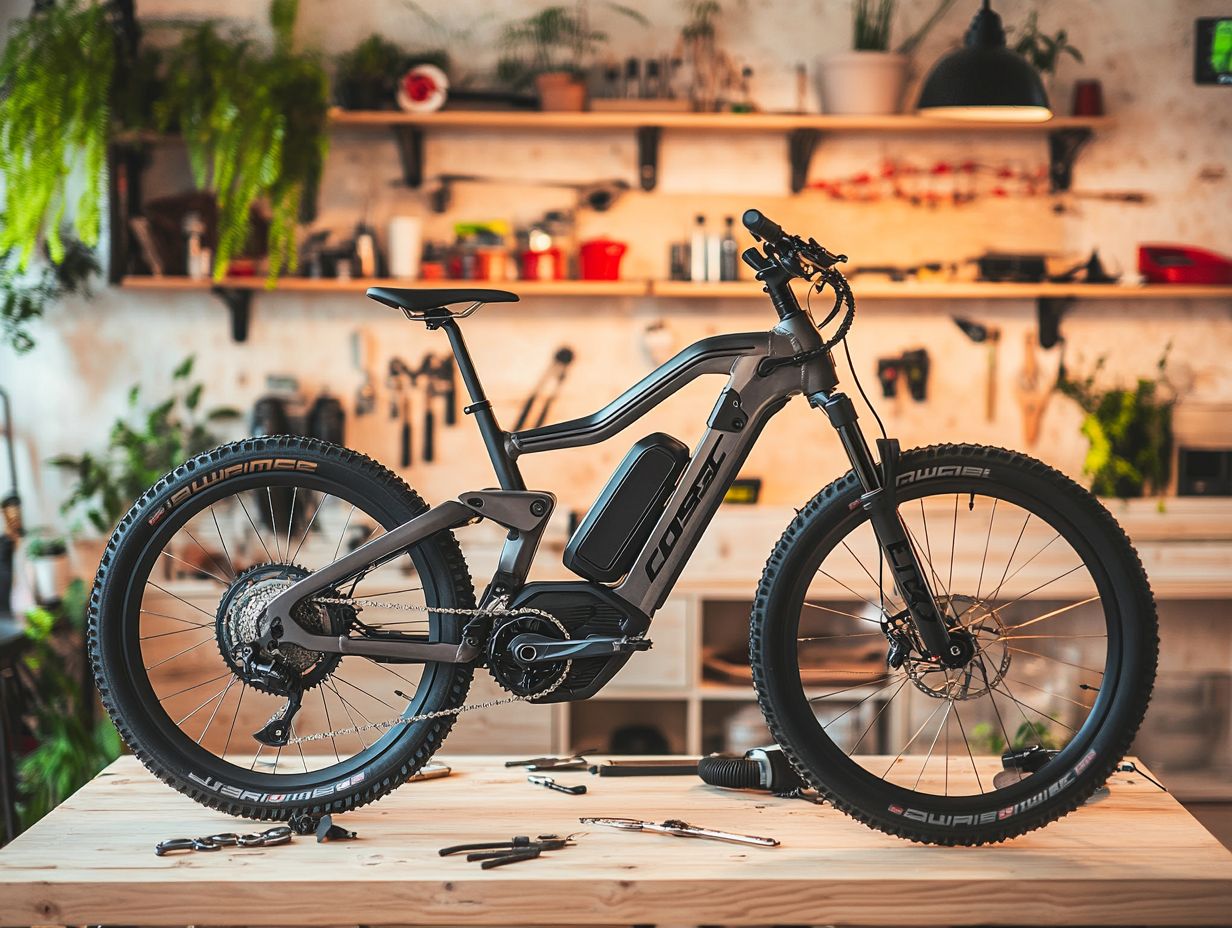
- Understanding the anatomy of your electric bicycle, including its 12 key components, is crucial for choosing the right one and maintaining it properly.
- The key components of an e-bike include the motor, battery, controller, and display, each serving an important function.
- Regular maintenance and following safety precautions can keep your electric bicycle in excellent condition and ensure a safe riding experience.
The Basics of Electric Bicycles
Electric bicycles, or e-bikes, represent a transformative approach to transportation. They blend the timeless appeal of cycling with modern features that make riding easier.
With an e-bike, you can enjoy the thrill of riding while benefiting from a system that helps you pedal. This system is powered by advanced components like lithium-ion batteries and electric motors.
These bicycles incorporate high-quality components, such as lithium-ion batteries from trusted brands, and electric motors, like the powerful 500W brushless rear hub motor. This allows you to tackle various terrains effortlessly. Whether you’re commuting through the city or seeking adventure on winding trails, e-bikes are your ideal companion. It’s also important to be aware of understanding your electric bicycle’s warranty to ensure you get the most out of your investment.
The Flyer brand offers a fantastic choice for anyone looking to ride in style. They provide a range of models tailored to suit different riding styles and personal preferences.
What is an Electric Bicycle?
An electric bicycle, or e-bike, is your modern companion on two wheels. It features an electric motor that assists you while you ride, making it perfect for various terrains and riding conditions.
This innovative transportation option uses a system that helps you pedal as soon as you start, amplifying your efforts. It makes challenging terrains feel effortless, whether you re using Shimano gears or enjoying a smooth ride with reliable Tektro brakes.
The blend of your power and electric support not only boosts your speed but also conserves your energy on those longer journeys. Many e-bikes are made from lightweight materials like aluminum or carbon fiber, making them easy to maneuver while delivering impressive performance.
With a variety of styles available including commuter, mountain, and folding models electric bicycles fit every rider’s style, whether you re casual or adventurous!
Don t miss out on the chance to ride into the future with an e-bike!
Types of Electric Bicycles
Electric bicycles come in three main types: Class 1, Class 2, and Class 3. Each class has unique motor setups and performance features.
Class 1 electric bicycles are pedal-assisted, meaning the motor helps you pedal. They deliver a natural cycling experience with a maximum speed of 20 mph. In contrast, Class 2 bikes offer a throttle option that allows you to activate the motor without pedaling, also capped at 20 mph.
If you re seeking a bit more thrill, Class 3 models provide pedal assistance up to 28 mph. This combines performance with a more vigorous ride that may require a helmet, depending on local laws.
Each class not only shapes your riding experience but also influences the legal regulations regarding where and how you can use these e-bikes.
The Anatomy of an Electric Bicycle
Understanding the anatomy of an electric bicycle, including its essential components and features, is vital for both prospective buyers and current owners. It encompasses 12 key components, such as the throttle, brake system, rear rack, gear shifter, and display.
These components significantly influence the bike’s functionality, safety, and overall riding experience. Among the crucial parts is the lithium-ion battery, which powers the electric motor. The throttle allows for precise speed control, while safety features like the brake system ensure a secure ride. To learn more about these essential elements, check out this guide on understanding the anatomy of electric bicycles.
Elements like the rear rack, gear shifter, display, kickstand, and bell enhance your e-bike’s convenience, making it perfectly suited for various cycling adventures. To fully appreciate these features, consider understanding the mechanics of electric bikes, whether you’re commuting or exploring new trails.
Key Components and Their Functions
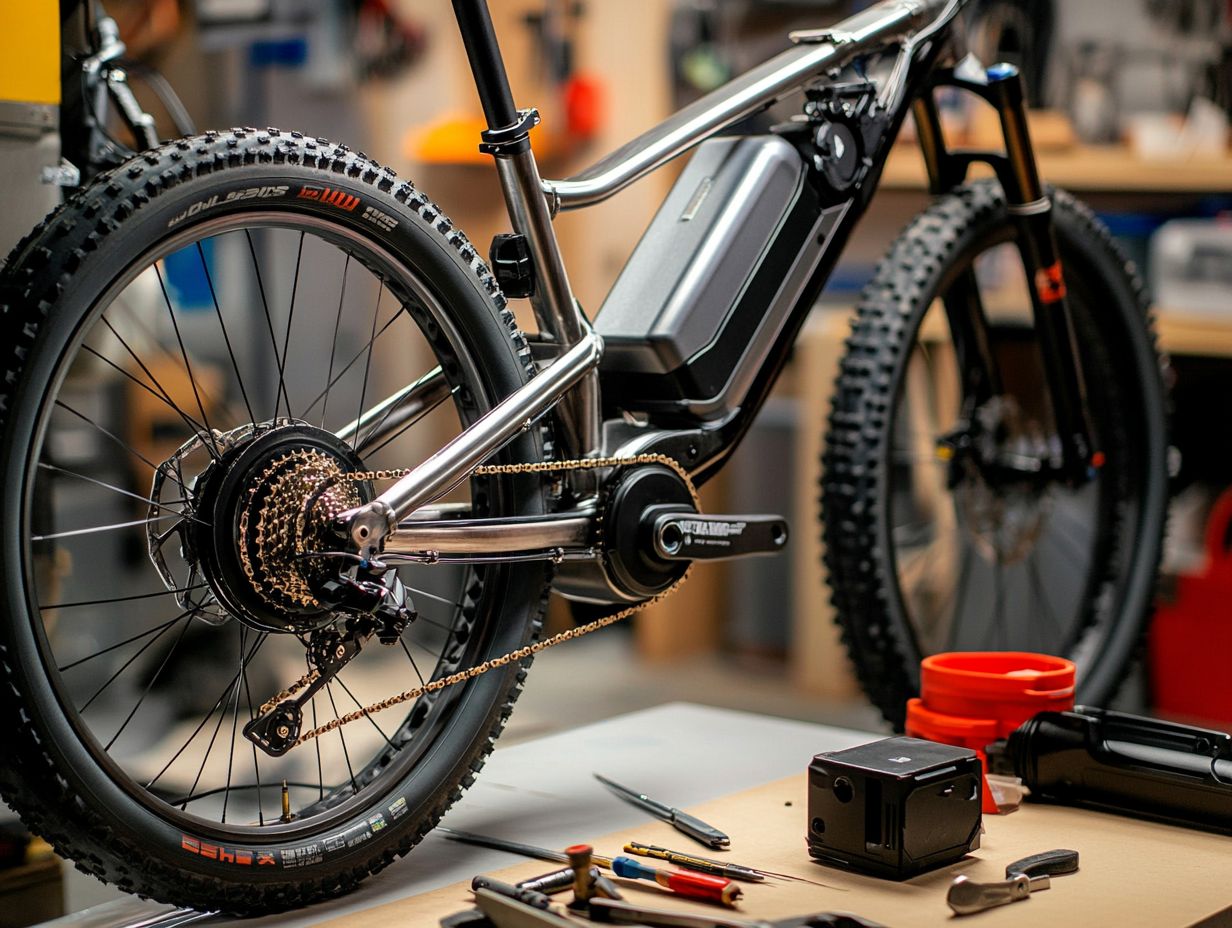
The key components of an electric bicycle each play vital roles that enhance your riding experience. The electric motor drives performance, while the lithium-ion battery provides long-lasting power.
The efficiency of the electric motor significantly impacts your bike s acceleration and overall performance. This is essential for achieving superior control across various terrains.
The bike s frame is designed with durability and stability in mind. It supports handling while accommodating the weight of the motor and battery, including those found in brands like Juiced Bikes and Flyer .
The transmission system, complete with gears, allows you to customize your cycling experience by shifting to optimal resistance depending on the incline of your route. Together, these components ensure a smooth, responsive ride, showcasing the many advantages of modern electric bicycles.
Choosing the Right Electric Bicycle for You
Choosing the right electric bike should excite you! It demands thoughtful consideration of various factors, such as your riding style, intended use, and specific components like the lithium-ion battery and electric motor.
Whether you seek a lightweight e-bike for effortless commuting or a sturdy model engineered for challenging terrains, understanding your unique requirements will empower you to make a well-informed choice.
Don’t miss out on the perfect ride for your adventures!
Electric Bicycle Guide
Factors to Consider
When selecting an electric bicycle, several key factors come into play. Consider battery capacity, motor power, and the overall weight of the bike. This is especially important if you re looking at high-performance options like the 500W brushless rear hub motor.
Battery capacity is key. It affects how far you can travel and how useful the bike is. You should feel confident traveling longer distances without worrying about recharging too soon.
Motor power is also significant. It impacts not just your speed but also how well the bike can handle inclines and various terrains, enhancing your riding experience.
The bike’s weight is another important factor. It affects maneuverability and transport ease. Finding a balance that meets your needs is essential for optimal performance during varied cycling conditions.
Each of these components plays an important part in determining how far and fast you can go. They also enhance the enjoyment and practicality of navigating through diverse environments.
Maintenance and Care for Your Electric Bicycle
Proper maintenance and care are essential for your electric bicycle’s longevity and optimal performance, especially regarding key components like the battery, electric motor, and brake system.
By conducting regular inspections of these components and addressing maintenance needs promptly, you can prevent costly repairs. Investing time in upkeep pays off with enhanced reliability and enjoyment on every ride.
Tips for Keeping Your E-Bike in Top Condition
To keep your electric bicycle in peak condition, focus on battery care, motor upkeep, and overall cleanliness.
Regularly check your battery’s health, particularly if it uses a common type found in many e-bikes. This directly impacts performance and range. Keep the battery properly charged and avoid extreme discharge and charge cycles.
Don t overlook the motor; inspecting it for dust and debris enhances performance. Make it a habit to clean and lubricate the moving parts as needed.
Incorporate general cleaning of the bike frame, wheels, and components into your routine. This prevents rust and wear, ultimately extending your electric bicycle’s lifespan and improving your riding experience.
Safety Tips for Riding an Electric Bicycle
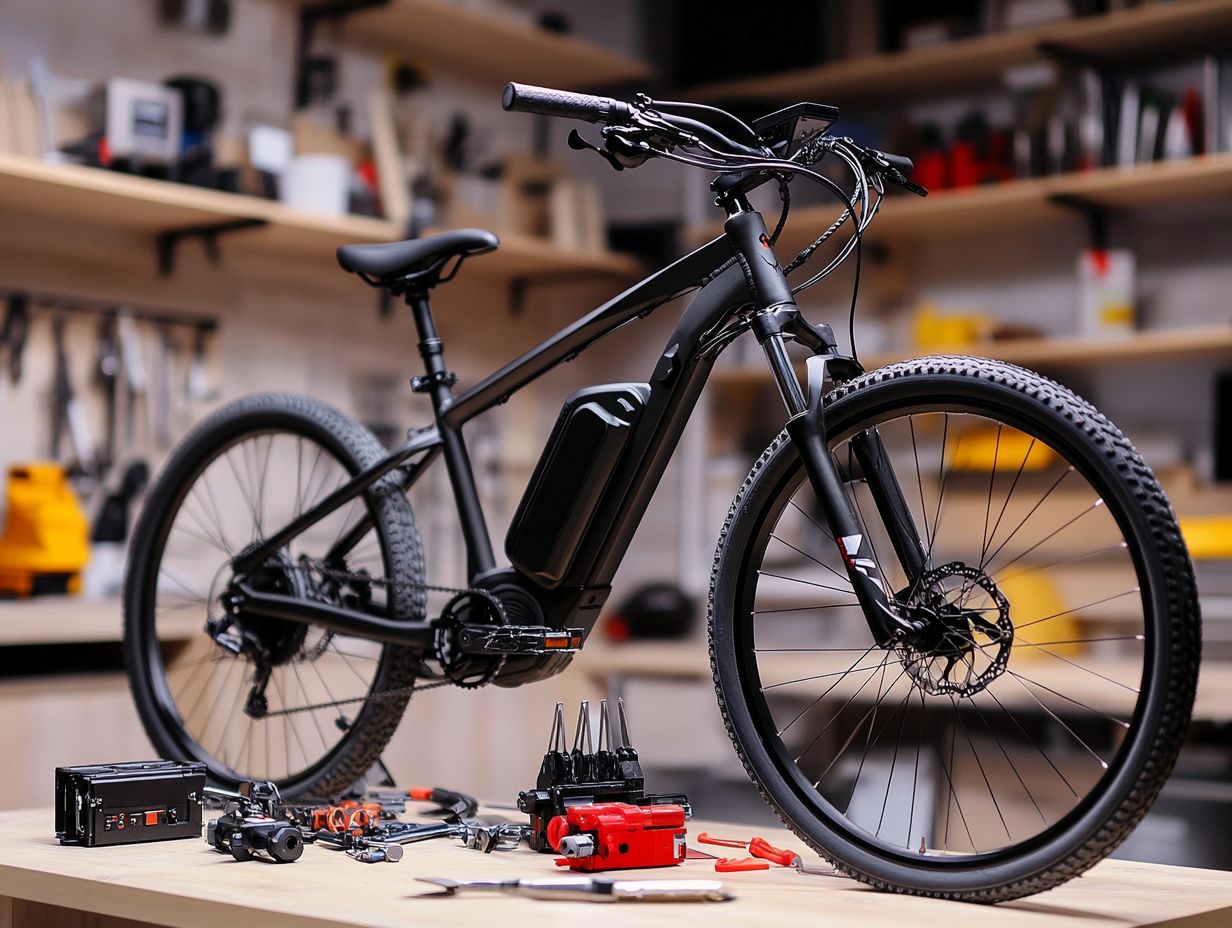
Safety is paramount when riding an electric bicycle, especially with features like pedal assist and throttle control. By following essential safety tips, you can enhance your riding experience and protect yourself from hazards.
Prioritize wearing a helmet, familiarize yourself with braking systems like Tektro and Shimano, and always obey traffic laws. These are key practices that every e-bike rider should adopt for a safer journey.
Precautions and Best Practices
Taking precautions and adhering to best practices while riding can significantly prevent accidents and ensure a safe journey, maximizing your enjoyment.
For e-bike riders, maintaining visibility is crucial. Wear bright, reflective clothing and use front and rear lights to enhance your presence on the road. Stay alert and familiarize yourself with local traffic laws, including lane usage and speed limits. These guidelines protect both you and pedestrians.
Embrace defensive riding by scanning your surroundings and anticipating the actions of others. This minimizes risks and leads to a more enjoyable experience. Implementing these strategies not only boosts your safety but also contributes to a culture of safety among all road users.
Don’t wait to check your battery! Start your journey to better biking today!
Common Issues and How to Fix Them
Grasping the common issues that can arise with electric bicycles is essential for you as an owner. Early detection and effective troubleshooting can save you time and hassle later!
Problems such as battery failures and motor malfunctions often stem from straightforward issues. Braking system glitches can also be easily resolved.
Troubleshooting Guide
A troubleshooting guide for electric bicycles can be invaluable. It helps you diagnose issues like low battery or motor malfunctions for a smoother riding experience.
By recognizing the symptoms linked to these common problems, you can take proactive steps to address them before they escalate. For example, if your bike struggles to start, it may indicate a low battery.
Unusual sounds from the motor could suggest internal wear or damage. This guide shows you how to fix problems and keep your ride smooth!
It also highlights the importance of regularly checking electrical connections and monitoring overall system performance. This ensures your electric bicycle remains reliable and prolongs its lifespan.
Frequently Asked Questions
What components make up an electric bicycle?
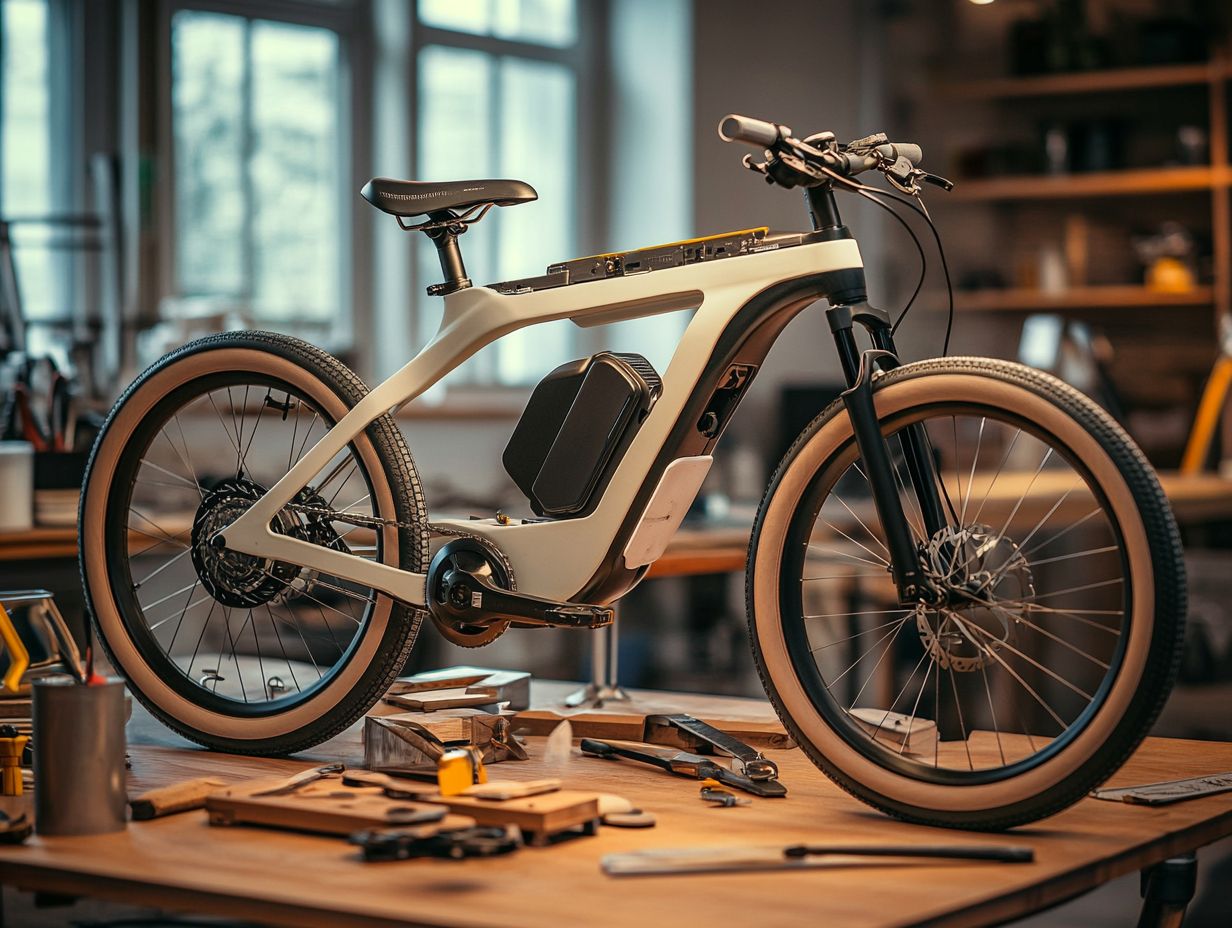
An electric bicycle typically consists of a battery, motor, controller, display console, brakes, gears, and frame. Some models may also include features like suspension, lights, and a throttle.
How does the battery work in an electric bicycle?
The battery is the main power source for an electric bicycle. It stores energy and supplies it to the motor, which powers the bike.
You can charge the battery by plugging it into a power outlet.
What is the difference between a hub motor and a mid-drive motor?
A hub motor is located in the center of the wheel and provides direct power to the wheel. In contrast, a mid-drive motor is found in the center of the bike and powers the pedals, offering a more natural riding experience and better efficiency.
What role does the display console play in an electric bicycle?
The display console acts as the control center for your electric bicycle. It allows the rider to view and adjust settings such as speed, power mode, battery life, and trip distance.
Some models may also feature GPS navigation or other advanced options.
How does regenerative braking work in an electric bicycle?
Regenerative braking captures energy from braking and uses it to recharge the battery. When the brakes are applied, the motor switches to generator mode.
This process converts kinetic energy into electrical energy, slowing down the bike and extending battery life.
What should I do if I need to replace a component on my electric bicycle?
If you need to replace a component, consult the user manual or contact the manufacturer for guidance. Always use parts that fit your bike and follow the installation guide.
This ensures the safety and functionality of your ride.
Start troubleshooting today to enjoy a safer and smoother ride!


